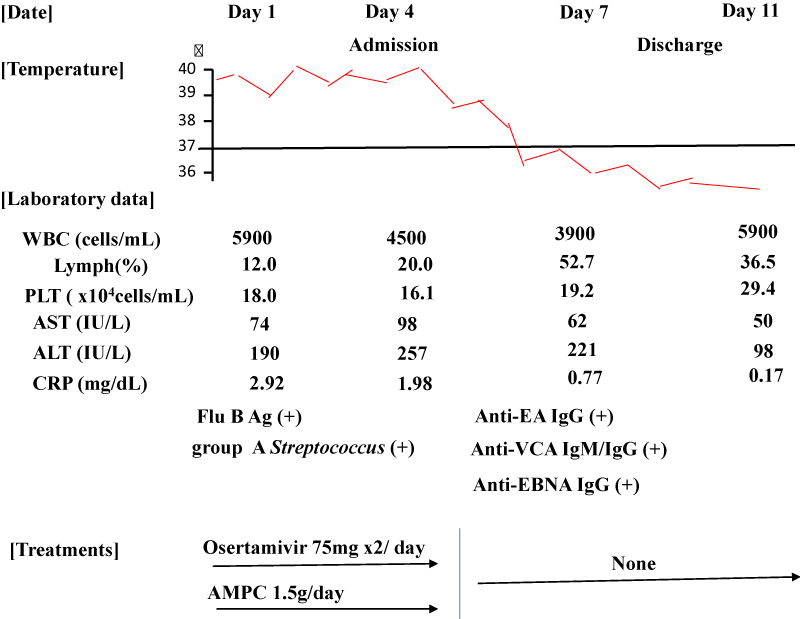Open Journal of Tropical Medicine
Coinfection of Influenza Virus and Group A Streptococcus in an Adult Suspected with Infectious Mononucleosis by Epstein-Barr Virus Infection
Masafumi Seki1*, Nozomi Oikawa1,2, Maya Hariu1,2 and Yuji Watanabe1,2
Cite this as
Seki M, Oikawa N, Hariu M, Watanabe Y (2016) Coinfection of Influenza Virus and Group A Streptococcus in an Adult Suspected with Infectious Mononucleosis by Epstein-Barr Virus Infection. Glob J Clin Virol 1(1): 005-007. DOI: 10.17352/gjcv.000002The patient was a 21 year-old male who showed high fever and an influenza virus B antigen positive nasal specimen. He was initially suspected as influenza-related bronchitis and pharyngitis by group A Streptococcus; however, his fever, sore throat and skin eruption did not improve although he was administered anti-influenza drugs and amoxicillin for four days. He was admitted to our hospital and underwent microbial and serological examinations. Serology indicated recent Epstein-Barr infections. His symptoms and fever declined during drug free observation. He was finally diagnosed as having a Epstein-Barr virus infection followed by coinfection of influenza B and group A Streptococcus with penicillin allergy, which may be relatively common in adults, and should be kept in mind.
Introduction
The Epstein-Barr virus (EBV) is a member of the herpesvirus family. Herpes viruses are common viruses that cause infectious mononucleosis (IM), which is characterized by fever, pharyngitis and lymphadenopathy[1,2]. At least 90% of the world’s population is infected with EBV and the virus can persist in a latent form after primary infection. EBV usually infects B cells and induces T-cell activation, which results in atypical lymphocyte proliferation [3].
In addition, in EBV infected patients, a decrease in hematopoietic cells due to administration of antibiotics, especially of penicillin, is usually found [4-6]. Therefore, on encountering febrile patients who have pharyngitis and skin rash, whether these symptoms are due to EBV infection or are due to another virus or bacteria should be carefully distinguished.
Here, we describe a patient who was diagnosed as having influenza B and bacterial pharyngitis and who received anti-influenza drugs and penicillin, but who showed continuous high fever, skin eruption, liver dysfunction and thrombocytopenia. He was suspected as having EBV co-infection with penicillin allergy and finally recovered after discontinuation of antimicrobial drugs.
Case Report
A 21-year-old man presented at the emergency room in March 2016 with acute sore throat and high fever accompanied by extreme fatigue that had persisted for two days, but he had been aware general malaise in last 1-2 week. He had a no medical history and never smoked. Physical examination indicated the following: temperature of 39.6 °C, blood pressure of 127/70 mmHg, respiratory rate of 18 breaths/min, and consciousness level of E4V4M6 on the Glasgow Coma Scale. There were no crackles (rhonchi) in either lung field and chest radiography indicated no infiltrative shadows, but his oral cavity was reddish and we found tonsil swelling. Cervical lymphadenopathy was not shown. Small skin eruptions were also found on his body (Figure 1). His initial white blood cell (WBC) count was 5900/L and the proportions were as follows: Neu 76%, Lymph 12%, Mono 10% and Eo 2%, respectively. C-reactive protein (CRP) level was 2.62 mg/dL. Group A Streptococcus (GAS) was identified in pharyngeal specimens by culture and rapid antigen test. In addition, the rapid antigen test for influenza B by nasal swab was also positive. We therefore diagnosed that him with influenza with mild bacterial pharyngitis due to GAS (Figure 2).
We started oral administration of 75 mg of oseltamivir twice, and 0.5 g of amoxicillin three times every 8 hours daily for 4 days; however, his high fever continued, and the skin eruptions, liver dysfunction and thrombocytopenia worsened.
Because he had general malaise last 1-2 week, we considered that he might also have been Epstein-Barr virus infection and might have an allergic reaction to the antimicrobial drugs, especially to penicillin. His drug administration was stopped and he was admitted to our hospital for observation.
Three days later (Day 6), he became afebrile and his liver function and platelet number improved soon after amoxicillin was stopped. Anti-early antigen (EA) IgG, -viral capsid antigen (VCA) IgM/IgG, and –Epstein Barr virus nuclear antigen (EBNA) IgG of EBV was positive. These data suggested the primary and recent 1-2 week infection of EBV, therefore, he was diagnosed as infectious mononucleosis due to EBV followed by co-infection with influenza virus and GAS. In addition, he might have allergic reaction for penicillin related to EBV infection because his symptom data improved by drug free. Splenomegaly was not found on abdominal computed tomography and he was discharged on day 8. His laboratory data had improved even more by day 11 at the outpatient clinic.
Discussion
Despite major efforts in prevention and treatment, influenza virus infection accounts for significant morbidity and mortality [7,8]. Which have been attributed to the development of respiratory complications, including pneumonia.
In this report, we described a case who was initially diagnosed as influenza and bacterial pharyngitis due to GAS but who was finally found to have a co-infection of EBV, which might have induced lymphocytopenia and liver dysfunction due to drug interaction by penicillin.
Primary EBV infection appears predominantly in children, adolescents and young adults [5]. Symptoms start with a prodromal phase including subfebrility, malaise, arthralgia and myalgia, similar to any common upper respiratory tract infection. However, the classic features of fever, tonsillopharyngitis, lymphadenopathy, leukocytosis and hepatosplenomegaly are characteristic of EBV, and are helpful in differentiating EBV infection from bacterial infection [6]. Skin eruptions may also develop during EBV infection [4]. These symptoms may develop due to the viral infection; however, these patients often use antibiotics. It is also well established that viral infections enhance the risk of drug allergic reactions [9,10].
In our case, the patient had fever, pharyngitis, leukocytosis and skin eruption, and these phenomena worsened after administration of antimicrobial agents.
Onodi-Nagy et al., investigated ten IM patients for drug sensitization using a lymphocyte transformation test and six patients were further tested by prick-, intradermal and patch tests employing the main antigens of penicillin [4]. They found negative results with amoxicillin while one patient had a positive reaction to cefixime. Six patients with suspected sensitization to amoxicillin were then investigated using in vivo tests. Prick tests were negative in all six patients, but the intradermal tests showed positive reactions in four patients. These results demonstrated the possibility that sensitization to aminopenicillin may develop within IM, and also showed the difficulty of finding definite cases of drug allergy in IM.
In addition, basic research showed that cross-reactive influenza virus–specific CD8+T cells contribute to lympho-proliferation in EBV–associated IM, and suggested that co-infection of influenza virus and EBV may enhance the characteristic symptoms and laboratory data of IM patients, such as fever, pharyngitis, skin eruption, leukocytosis and liver dysfunction which were also influenced by allergic reactions to drugs such as penicillin [3].
An epidemiological report indicated that co-infection of influenza and EBV may be relative common [2]. The frequency of occurrence of multipathogen infections in children with primary EBV was 68.9%, which was significantly higher than that in the past-infected group or the uninfected group. Of the multipathogen-infected patients, the incidence of Chlamydia pneumoniae in children with primary infection was as high as 50%, which was significantly higher than in the other groups, including groups with influenza. The authors reported that fever, rash, lymphadenopathy, hepatomegaly, splenomegaly, avtypical lymphocytes and abnormal liver function were more frequent in the patients with multipathogen infection and EBV primary infection, and the length of hospital stay and duration of fever were longer than in other patients. That study suggests that there is not a high incidence of co-infection of EBV and influenza virus, but, if such co-infection occurs, these patients may display a more severe status and show allergic reactions, compared with patients with either EBV or influenza virus infection alone.
In conclusion, our patient was infected with EBV followed by influenza virus and GAS infection. Although anti-influenza drugs and amoxicillin were used in this patient, his characteristic symptoms and laboratory data might worsen due to drug allergy induced by superinfected EBV. The risk of co-infection of EBV in influenza and/or GAS should be considered when young pharyngitis patients are encountered, and care should be taken in drug administration to such patients, especially in penicillin use. This is the educative case for physicians and clinical microbiologists.
This work was supported by the Japanese Society for the Promotion of Science Grant-in-Aid for Scientific Research 26461158 (to M.S.).
- Cohen JI (2000) Epstein-Barr virus infection. N Engl J Med 343: 481-492. Link: https://goo.gl/ff1zmE
- Wang X, Yang K, Wei C, Huang Y, Zhao D (2010) Coinfection with EBV/CMV and other respiratory agents in children with suspected infectious mononucleosis. Virol J 7: 247-257. Link: https://goo.gl/1aBRgS
- Clute SC, Watkin L, Cornberg M, Naumov YN, Sullivan JL, et al. (2005) Cross-reactive influenza virus-specific CD8+ T cells contribute to lymphoproliferation in Epstein-Barr virus-associated infectious mononucleosis. J Clin Invest 115: 3602-3612. Link: https://goo.gl/rwRTYm
- Ónodi-Nagy K, Kinyó A, Meszes A, Garaczi E, Kemény L, et al, (2015) Amoxicillin rash in patients with infectious mononucleosis: evidence of true drug sensitization. Allergy Asthma Clin Immunol 11: 1. Link: https://goo.gl/3I6t8g
- Chovel-Sella A, Ben Tov A, Lahav E, Mor O, Rudich H, et al. (2013) Incidence of rash after amoxicillin treatment in children with infectious mononucleosis. Pediatrics 131: 1424-1427. Link: https://goo.gl/joO8h
- Leung AK, Rafaat M (2003) Eruption associated with amoxicillin in a patient with infectious mononucleosis. Int J Dermatol 42: 553-555. Link: https://goo.gl/9Lq6yr
- Seki M, Kosai K, Yanagihara K, Higashiyama Y, Kurihara S, et al. (2007) Disease severity in patients with simultaneous influenza and bacterial pneumonia. Intern Med 46: 953-958. Link: https://goo.gl/4v8Qk8
- Mauad T, Hajjar LA, Callegari GD, da Silva LF, Schout D, et al, (2010) Lung pathology in fatal novel human influenza A (H1N1) infection. Am J Respir Crit Care Med 181: 72-79. Link: https://goo.gl/JEDXQ9
- Renn CN, Straff W, Dorfmüller A, Al-Masaoudi T, Merk HF, et al. (2002) Amoxicillin-induced exanthema in young adults with infectious mononucleosis: demonstration of drug-specific lymphocyte reactivity. Br J Dermatol 147: 1166-1170. Link: https://goo.gl/F2vbn5
- Jappe U. (2007) Amoxicillin-induced exanthema in patients with infectious mononucleosis: allergy or transient immunostimulation? Allergy 62: 1474-1475. Link: https://goo.gl/D0wYt1
Article Alerts
Subscribe to our articles alerts and stay tuned.
 This work is licensed under a Creative Commons Attribution 4.0 International License.
This work is licensed under a Creative Commons Attribution 4.0 International License.



 Save to Mendeley
Save to Mendeley
